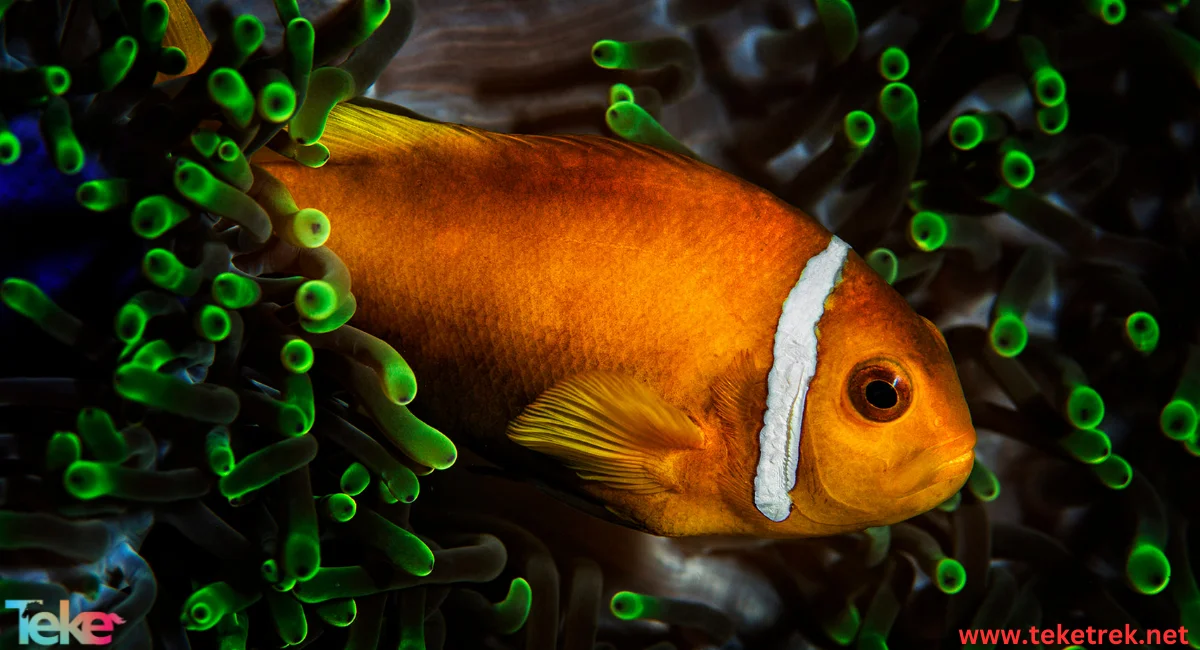The clownfish has an interesting and rare life cycle, where all individuals hatch as males, and during breeding, one of the males transforms into a female to produce a new generation.
Clownfish live near coral reefs and have a strange symbiotic relationship with them. If you’re curious to learn more about clownfish, continue reading this special article.Let’s explore more about these fascinating creatures from teke trek.
The clownfish External Appearance
the clownfish can have many different colors depending on their species, including yellow, orange, red, and black, most with white stripes.
Clownfish size is small , with the smallest being about 7 to 8 cm and the largest 17 cm. Usually, female clownfish are larger than males.
Clownfish belong to the phylum Chordata, subphylum Vertebrata, and class Actinopterygii.

Clownfish Habitat
Clownfish are found in warm waters, protected coral reefs or lagoons, and live in sea anemones.
They can be found in coral reefs in the Indian Ocean, the Red Sea, and the western Pacific Ocean. They are also found off the coasts of Australia and Southeast Asia, as well as in the southern waters of Japan.
Breeding Stages:
The clownfish live for about 8 years in the wild and up to 12 years in captivity. Interestingly, all clownfish are born male, then one male clownfish changes sex for breeding, and once this change occurs, it cannot be reversed.
Clownfish are social fish, communicating through popping and clicking sounds, living in groups of male fish with one dominant female, one dominant male, and a group of smaller males. The dominant male ensures his status by exploiting the best feeding opportunities.
If the group’s female dies, the dominant male will permanently transform into a female, and the next largest male will become the next dominant male.
A female clownfish can lay thousands of eggs, which are then fertilized by the male. The male usually eats any damaged or sterile eggs.
Symbiotic Relationship:
Clownfish live in a mutual symbiotic relationship with sea anemones.
- Sea anemones protect the clownfish from predators and provide food leftovers.
- In return, the clownfish use their bright colors to attract fish to the sea anemones, which are then killed by the anemone’s venom and eaten.
- Clownfish also fertilize the sea anemones with their waste.
- Before settling, clownfish perform a sophisticated dance with the sea anemones, gently touching their tentacles with different parts of their bodies until they get used to their host.
- The sea anemone’s fish-eating sting becomes ineffective due to a mucus layer on the clownfish’s skin.
- Clownfish provide protection from predators and food leftovers, as they expel intruders and parasites from their host.

What is Clownfish diet?
Despite their beautiful appearance, clownfish are carnivorous animals, meaning they eat both meat and plants. Their diet includes crustaceans, algae, zooplankton, and worms.
What are 5 facts about clownfish?
- The clownfish eggs can hatch at any time during the year.
- After laying eggs, the male clownfish guards them until they hatch.
- Male clownfish are the primary caregivers for their young, with females only helping occasionally.
- Clownfish communicate by making popping and clicking sounds.
- Clownfish are known for their bright colors, but they can also be seen in black with white stripes.
- In one birth, a female clownfish can lay up to 1000 eggs.
- Although clownfish are marine animals, they are poor swimmers. They rarely leave their sea anemones, and when they do, they swim in erratic, out-of-control patterns.
- Female clownfish, the most aggressive, lead their group, although most animal kingdoms have males at the top of the hierarchy.
The faqs about clown fish.
- How do clownfish adapt?
They use special adaptations such as fins, gills, and bladders to survive. Most of them are ectothermic, meaning their body temperature depends on the temperature of the water around them.
- What does a clown fish look like?
The clownfish is distinguished by its beautiful orange color with white lines that cut the orange color in the form of long lines, so that its body becomes striped in white and orange.
- Does clown fish change sex?
The offspring are male, and the male can change his sex when the dominant female dies to become a female.
- How long do clown fish live?
Clownfish live about 8 years in the wild and 12 years or more in a protected environment
- Why is the clown fish called the clown fish?
The name, as you might imagine, is derived from the bold color of most clownfish, which is reminiscent of the bold color combination you might find in a clown costume.
- Are clown fish friendly?
Despite the familiar name, clownfish can be very aggressive. They are known to fiercely defend their territory.
- Why can clownfish change genders?
Because it has both male and female reproductive organs.
- Who eats clownfish?
Arger fish, including lionfish and snappers, can eat clownfish.
- Is Nemo a real clownfish?
Yes Nemo is clownfish.
In conclusion, the clownfish are very popular in the aquarium trade. Some individuals are bright orange and white, while others are dark black and white. The striking colors and relationship with sea anemones make this species highly desirable for both public and private aquariums.
Human threats pose a significant risk to clownfish, especially in recent years, as the internet has made these species very popular.





